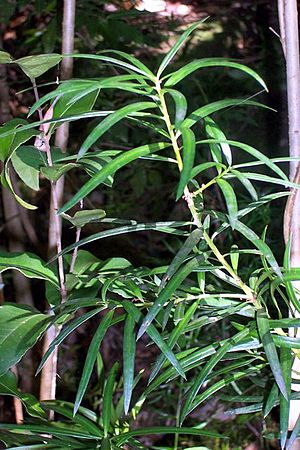Dwarf plum pine facts for kids
The dwarf plum pine (scientific name: Podocarpus spinulosus) is a special type of shrub or small tree. It's also known as the spiny-leaf podocarp because of its pointy leaves. This plant is found along the coast in parts of New South Wales and southern Queensland, Australia.
Quick facts for kids Dwarf plum pine |
|
|---|---|
 |
|
| Podocarpus spinulosus at Chatswood West, Australia | |
| Conservation status | |
| Scientific classification | |
| Genus: |
Podocarpus
|
| Species: |
spinulosus
|
Contents
Discovering the Dwarf Plum Pine
The dwarf plum pine is a unique plant that grows in warm coastal areas. It is usually found growing underneath taller trees, acting as an understorey shrub. This means it lives in the shade of bigger plants.
What Does It Look Like?
This plant is often a shrub and usually doesn't grow taller than 2 meters (about 6.5 feet). Its leaves are like needles, measuring between 2 and 8 centimeters (about 1 to 3 inches) long. They are sharply pointed and green on top.
Special Leaves
If you look closely at the underside of the leaves, you'll see whitish-blue lines. These lines are where tiny pores, called stomata, are located. These pores help the plant "breathe" by exchanging gases with the air.
How Does It Reproduce?
The dwarf plum pine produces berry-like cones. These cones have a soft, fleshy part called an aril. This aril is purple-black when ripe and is about 1 to 2 centimeters (about 0.4 to 0.8 inches) long.
Seeds and Fruit
Inside the aril, there is usually one (sometimes two) seeds. Each seed is about 1 centimeter (about 0.4 inches) long. The fleshy aril is edible, which means some animals might eat it and help spread the seeds.
History of Its Name
The dwarf plum pine was first described in 1817 by a scientist named James Edward Smith. He first called it Taxus spinulosa. Later, in 1825, it was given its current scientific name, Podocarpus spinulosus.


